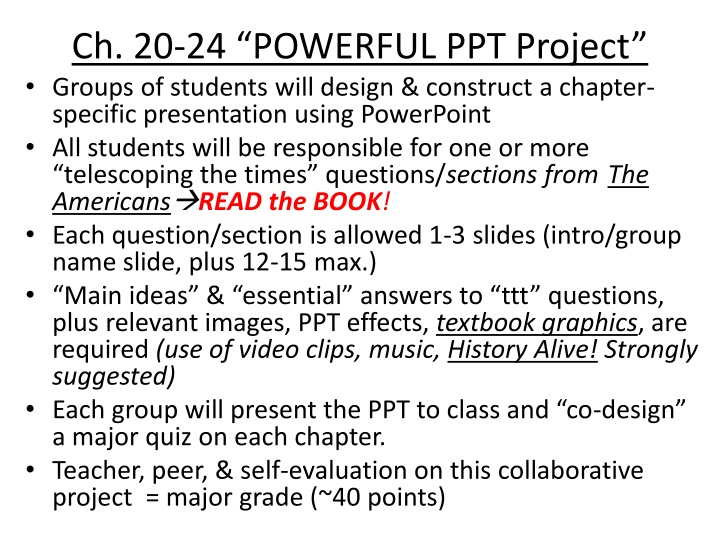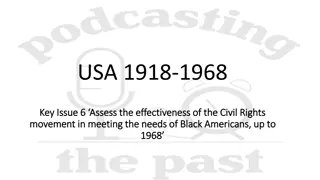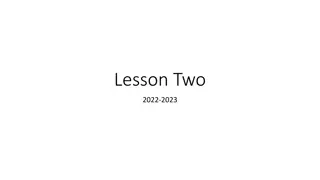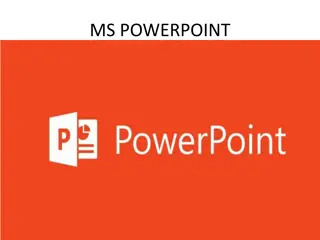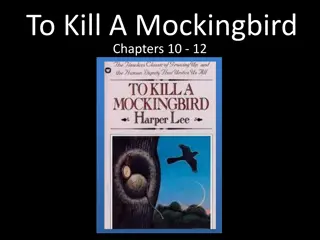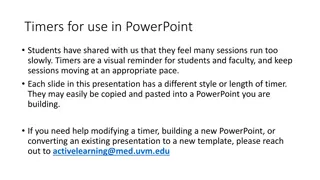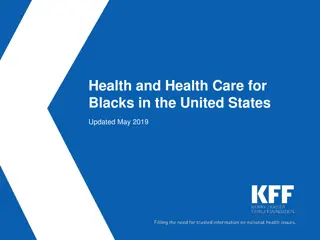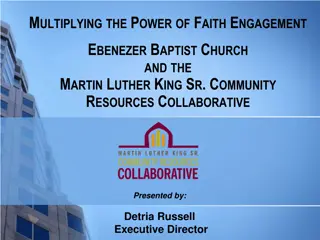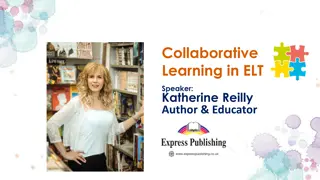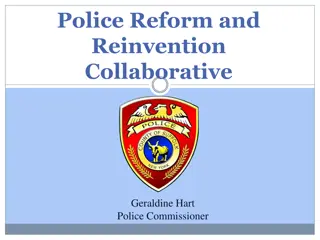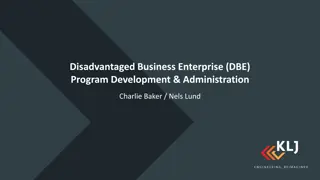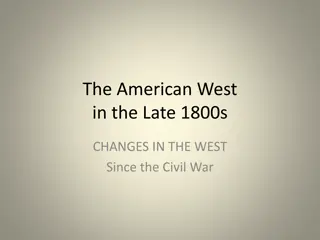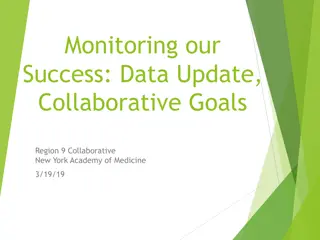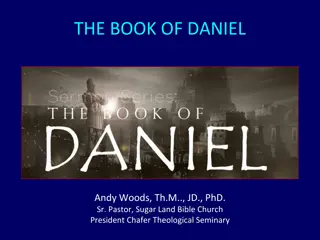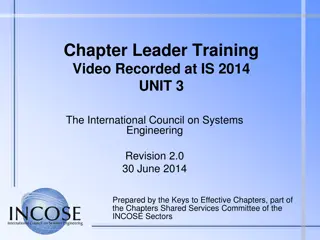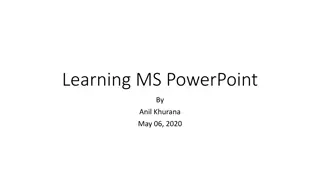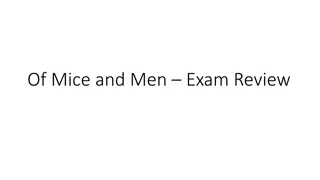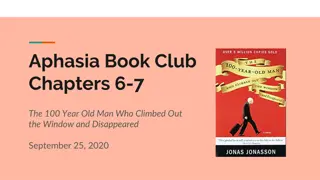Collaborative PowerPoint Project on Chapters 20-24 of 'The Americans'
Design a collaborative PowerPoint presentation on chapters 20-24 of 'The Americans' where groups of students will delve into specific questions/sections, incorporating main ideas, essential answers, relevant images, and multimedia effects. Each group will present their PPT to the class and co-create a quiz on the chapter. Additional points can be earned through creative skits or games related to the content. Evaluation will include teacher, peer, and self-assessment. Explore the historical events and societal changes outlined in the chapters through engaging presentations and activities.
Download Presentation

Please find below an Image/Link to download the presentation.
The content on the website is provided AS IS for your information and personal use only. It may not be sold, licensed, or shared on other websites without obtaining consent from the author.If you encounter any issues during the download, it is possible that the publisher has removed the file from their server.
You are allowed to download the files provided on this website for personal or commercial use, subject to the condition that they are used lawfully. All files are the property of their respective owners.
The content on the website is provided AS IS for your information and personal use only. It may not be sold, licensed, or shared on other websites without obtaining consent from the author.
E N D
Presentation Transcript
Ch. 20-24 POWERFUL PPT Project Groups of students will design & construct a chapter- specific presentation using PowerPoint All students will be responsible for one or more telescoping the times questions/sections from The Americans READ the BOOK! Each question/section is allowed 1-3 slides (intro/group name slide, plus 12-15 max.) Main ideas & essential answers to ttt questions, plus relevant images, PPT effects, textbook graphics, are required (use of video clips, music, History Alive! Strongly suggested) Each group will present the PPT to class and co-design a major quiz on each chapter. Teacher, peer, & self-evaluation on this collaborative project = major grade (~40 points)
Ch. 20-24 POWERFUL PPT Project Work now, LEARN from each other, and later you can share your c cr re ea at ti iv vi it ty y in a dramatic and/or playful way! Groups that act out a skit or create a game of any useful kind will earn additional points!
Chapter 20, Americans p. 668-697 The New Frontier and the Great Society Responses will vary but should include points similar to the following: 1. The U.S. and Soviet Union clashed over the placement of missiles in Cuba, which resulted in their removal by the Soviets, and over access to Berlin, which resulted in the Soviets building of the Berlin Wall. 2. Kennedy was unable to get Congress to pass bills to provide medical care for the aged, to rebuild cities, and to aid education, but he did win support for increased defense spending, a hike in the minimum wage, and the creation of the Peace Corps. 3. Johnson s Great Society comprised many measures such as civil rights protection, Medicare and Medicaid to provide health care for the aged and poor, funding for public housing, an end to immigration quotas, efforts to clean water, and consumer protection. 4. The Warren Court issued rulings that changed the rules for creating legislative districts and enhanced the rights of people accused of crimes.
1. How did the United States and Soviet Union confront each other during Kennedy s term and how did the situations end? The U.S. and Soviet Union clashed over the placement of missiles in Cuba, which resulted in their removal by the Soviets, and over access to Berlin, which resulted in the Soviets building of the Berlin Wall. Flexible response ability to react to threats, including nonnuclear, in a variety of ways (troops, ships, artillery); explained by Sec. of Defense, Robert McNamara hot line between the White House and the Kremlin (Moscow) Initially, communism was advancing (US appeared weak) Bay of Pigs (Cuban exiles are trained to orchestrate a revolution )
2. What policies did Kennedy push, and how well did he succeed in having them passed? Kennedy was unable to get Congress to pass bills to provide medical care for the aged, to rebuild cities, and to aid education, but he did win support for increased defense spending, a hike in the minimum wage, and the creation of the Peace Corps.
3. Describe Johnsons Great Society. Johnson s Great Society comprised many measures such as civil rights protection, Medicare and Medicaid to provide health care for the aged and poor, funding for public housing, an end to immigration quotas, efforts to clean water, and consumer protection.
4. What decisions were made by the Supreme Court under Earl Warren? The Warren Court issued rulings that changed the rules for creating legislative districts and enhanced the rights of people accused of crimes (Miranda rights) one person, one vote
History Alive! Ch. 43: Two Americas Why did poverty exist in an age of influence?
Chapter 21, Americans p. 698-727 Civil Rights Responses will vary but should include points similar to the following: 1.The civil rights movement began with changes caused by World War II. The NAACP pushed lawsuits that won African Americans the right to desegregation in education. The Montgomery bus boycott prompted the rise of Martin Luther King, Jr., as a leader of the movement. 2. Violent attacks on civil rights workers in the South prompted President Kennedy to ask Congress for a civil rights law. A massive march on Washington and his assassination, as well as President Johnson s skill, led to its passage. The Voting Rights Act was passed due to Johnson s support after another massive march in the South. 3. The civil rights movement changed as it tried to dislodge de facto segregation in the North and as angrier voices called for strong resistance to white racism. 4. The civil rights movement had mixed results in that it succeeded in overturning many discriminatory laws but could not unseat entranced de facto discrimination. Many African Americans still suffer from poverty and the lack of opportunities.
Chapter 21 Civil Rights 1. How did the civil rights movement begin? The civil rights movement began with changes caused by World War II. The NAACP pushed lawsuits that won African Americans the right to desegregation in education. The Montgomery bus boycott (Rosa Parks) prompted the rise of Martin Luther King, Jr., as a leader of the movement. -post-WW II (fairness, real jobs, better pay) Tuskeegee Airmen Redtails -Brown v. Board of Education Topeka, Kansas (1954) Americans, p. 698-727
Chapter 21, Civil Rights 2. What events led Congress to pass the Civil Rights and Voting Rights acts? Violent attacks on civil rights workers in the South prompted President Kennedy to ask Congress for a civil rights law. A massive march on Washington and his assassination, as well as President Johnson s skill, led to its passage. The Voting Rights Act was passed due to Johnson s support after another massive march in the South. -( Bloody Sunday, first of two marches) Americans, p. 698-727
Chapter 21 Civil Rights 3. How did the civil rights movement change? The civil rights movement changed as it tried to dislodge de facto segregation in the North and as angrier voices called for strong resistance to white racism. -laws vs. attitudes (common practice) -Malcolm X & the Black Panthers (Power movement) Americans, p. 698-727
Chapter 21, Civil Rights Americans, p. 698-727 4. Why could the results of the movement be called mixed? The civil rights movement had mixed results in that it succeeded in overturning many discriminatory laws but could not unseat entrenched de facto discrimination. Many African Americans still suffer from poverty and the lack of opportunities. -housing, voting rights, schooling, etc.
Chapter 22, Americans p. 728-765 The Vietnam War Years 1. The U.S. entered the war in Vietnam to try to support the government of the South because it did not want communists in the North to control the whole country. 2. The U.S. could not quickly defeat the Vietcong because they engaged in guerrilla tactics of quick attacks and disappearing into the jungle. The result was a loss of morale among U.S. soldiers. 3. As the war continued and victory seemed less achievable, American society split into hawks, who favored the war, and doves, who opposed it. They were bitterly opposed to each other, and some hawks thought that antiwar protesters were disloyal. 4. The year 1968 was marked by loss of confidence and violence: a major North Vietnamese offensive weakened American support for fighting the war. Also, President Johnson decided not to seek re-election, two major leaders were killed, and violence marred the Democratic convention. 5. As a result of the war in Vietnam, many American soldiers were dead or wounded, and many more scarred by their reception when they returned home. The war created deep divisions in American society and opened mistrust of people toward the government
Chapter 22 The Vietnam War Years 1. Why did the U.S. enter the war in Vietnam? The U.S. entered the war in Vietnam to try to support the government of the South because it did not want communists in the North to control the whole country. -containment; Eisenhower supported Diem (opposed Ho); USS Maddox/Gulf of Tonkin incident (Resolution) Additional details/answers? Americans, p. 728-765
Chapter 22 The Vietnam War Years 2. Why could the U.S. not win a quick victory over the Viet Cong, and what was the effect? The U.S. could not quickly defeat the Vietcong because they engaged in guerrilla tactics of quick attacks and disappearing into the jungle. The result was a loss of morale among U.S. soldiers. -political limitations were placed on superior US weapons & numbers (military was not effective ); enemy was difficult to identify; napalm (incendiary/explosive); agent orange (defoliant); civil war (self-determination) QUAGMIRE! -Additional details/answers? Americans, p. 728-765
Chapter 22 The Vietnam War Years 3. How did public opinion split over the war? As the war continued and victory seemed less achievable, American society split into hawks, who favored the war, and doves, who opposed it. They were bitterly opposed to each other, and some hawks thought that antiwar protesters were disloyal. - draft dodgers fled to Canada or burned draft cards; returning vets greeted harshly (spit on); Additional details/answers? Americans, p. 728-765
Chapter 22 The Vietnam War Years 4. Why is 1968 considered a year of upheaval? The year 1968 was marked by loss of confidence and violence: a major North Vietnamese offensive* weakened American support for fighting the war. Also, President Johnson decided not to seek re-election, two major leaders (MLK and Robert Kennedy) were killed, and violence marred the Democratic convention. -*Tet Offensive; presidential advisors questioned the war; Nixon elected president Additional details/answers? Americans, p. 728-765
Chapter 22 The Vietnam War Years 5. What were the effects of the war? As a result of the war in Vietnam, many American soldiers were dead (58,000+) or wounded (158- 303,000+), and many more scarred by their reception when they returned home. The war created deep divisions in American society and opened mistrust of people toward the government. -Tet Offensive (lied about success? ); changed US foreign policy (Congressional limits on troop commitments); Pentagon Papers Additional details/answers? Americans, p. 728-765
History Alive! Ch. 51: The U.S. Gets Involved in Vietnam Why did the United States increase its military involvement in Vietnam? Ch. 52: Facing Frustration in Vietnam What made the Vietnam War difficult to win? Ch. 53: Getting Out of Vietnam What lessons for Americans emerged from the Vietnam War?
Chapter 23, Americans p. 766 -789 An Era of Social Change Responses will vary but should include points similar to the following: 1. To win higher wages and better benefits, Latinos farm workers organized into a union. Other Latinos formed political groups to field candidates. 2. Many Native Americans, unhappy with past government policies, came together to issue the Declaration of Indian Purpose, which called for freedom to choose their own way of life. Some Native Americans formed the American Indian Movement to push for faster results. Others used lawsuits to win education and land rights. 3. The women s movement succeeded in winning better treatment on the job and better access to education. But it failed to win approval of the Equal Rights Amendment. 4. The counterculture faded because hippies found they could not survive without mainstream society and because of problems caused by drugs. It changed art and fashion and helped increase the influence of rock n roll, however.
Chapter 23 An Era of Social Change 1. What did Latinos do to fight for equality? To win higher wages and better benefits, Latino farm workers organized into a union. Other Latinos formed political groups to field candidates. Americans, p. 766-789
Chapter 23 An Era of Social Change 2. What did Native Americans want? Many Native Americans, unhappy with past government policies, came together to issue the Declaration of Indian Purpose, which called for freedom to choose their own way of life. Some Native Americans formed the American Indian Movement to push for faster results. Others used lawsuits to win education and land rights. Americans, p. 766-789
Chapter 23 An Era of Social Change 3. Describe the successes and failures of the women s movement in the 1960s. The women s movement succeeded in winning better treatment on the job and better access to education. But it failed to win approval of the Equal Rights Amendment. -Roe v. Wade; birth control pill; more women attended higher education; Betty Friedan wrote The Feminine Mystique -ERA is defeated; Bella Abzug & Gloria Steinem (activist & creator of Ms. Magazine) (NWPC); NOW (National Organization for Women); comparable worth ($); glass ceiling Additional details/answers? Americans, p. 776-779 Alive! 716-717
Chapter 23 An Era of Social Change Alive! Ch. 50, p. 649-653 4. What caused the downfall of the counterculture and what lasting value did it have? The counterculture faded because hippies found they could not survive without mainstream society and because of problems caused by drugs. It changed art and fashion and helped increase the influence of rock n roll, however. --Woodstock (3 days of peace, love, & music); famous rock stars died (Jimi Hendrix & Janis Joplin); Haight- Ashbury-San Francisco, CA hippie capital ; Beatles arrive 1964; -The Beat Movement (Beatniks) of the 50s evolved into the hippies of the 60s & 70s Americans, p. 781-784
Chapter 24, Americans p. 792-827 An Age of Limits Responses will vary but should include points similar to the following: 1. Nixon reversed past U.S. policy by opening relations with Communist China and pursued more friendly relations with the Soviet Union. 2. The cover-up of Watergate represented the president s effort to block investigations, thus trying to put himself above the law. 3. Ford tried to end inflation with energy conservation and higher interest rates. Carter tried to use voluntary price freezes and spending cuts. 4. The debate over environmental laws focus on the need for economic development and for protection of natural resources.
Chapter 24 An Age of Limits 1. How did Nixon ease Cold War tensions? Nixon reversed past U.S. policy by opening relations with Communist China and pursued more friendly relations with the Soviet Union. Americans, p. 792-827 Alive! P. 697-707
Chapter 24 An Age of Limits 2. Why was Watergate a constitutional crisis? The cover-up of Watergate represented the president s effort to block investigations, thus trying to put himself above the law. -Nixon resigned instead of facing impeachment (August 8, 1974); burglary & high crimes & misdemeanors were committed (1972) while spying on Democratic National Headquarters; failure to disclose activity led to Nixon s downfall, & tape recorded conversations sealed his fate Americans, p. 802-807 Alive! P. 704-707
Chapter 24 An Age of Limits 3. How did Ford and Carter try to fix economic problems, and why didn t their plans work? Ford tried to end inflation with energy conservation and higher interest rates. Carter tried to use voluntary price freezes and spending cuts. Americans, p. 792-827
Chapter 24 An Age of Limits 4. What differing needs are the focus of the debate over environmental laws? The debate over environmental laws focus on the need for economic development and for protection of natural resources. -Earth Day (4/22/1970); Environmental Protection Act (EPA); Clean Water (1972) and Safe Drinking Water Act (1974); Three Mile Island accident (3/28/1979) Americans, p. 792-827 Alive! p. 714-715
